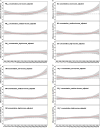Effect Modification by Socioeconomic Status on the Associations between Early Placental Protein Damage and Exposure to Ambient Air PM2.5 Chemical Components
- PMID: 40245380
- PMCID: PMC12101572
- DOI: 10.1289/EHP15170
Effect Modification by Socioeconomic Status on the Associations between Early Placental Protein Damage and Exposure to Ambient Air PM2.5 Chemical Components
Abstract
Background: Ambient fine particulate matter with aerodynamic diameter () exposure is associated with systemic protein damage in pregnant women. However, its effect on protein damage in human placentas is unclear.
Objectives: We estimated the associations of and chemical component exposures with advanced oxidation protein products (AOPP) in placental villi tissues before 13 weeks of gestation.
Methods: We enrolled 165 women with unintended normal early pregnancy (NEP) who requested induced abortion during the first trimester and 165 women with early pregnancy loss (EPL) who also requested induced abortion (2017-2022). Maternal daily , black carbon (BC), organic matter (OM), sulfate, nitrate, and ammonium exposures from the 12th week before ovulation to villi collection were estimated using data accessed from the Tracking Air Pollution in China platform. Associations of pollutant exposures during the 30 days before villi collection, during the post-conception period (from ovulation to villi collection), and during the periovulatory period (from the 12th week before to the third week after ovulation) with villi AOPP were estimated and compared between the NEP and EPL groups. Additionally, effect modifications by socioeconomic status expressed in family monthly income per capita were estimated using stratified distributed lag nonlinear models.
Results: Thirty-day cumulative and average post-conception exposures to higher concentrations of , BC, and OM were associated with higher villi AOPP in all subjects and both groups. Thirty-day cumulative effects of per interquartile range increase in the residuals of BC and OM were robust in EPL [ values (95% confidence interval) of villi AOPP were 111.22% (17.96%, 278.24%) and 93.87% (20.63%, 211.56%)] but were not robust in NEP. The associations of per interquartile range increase in the concentrations of BC and OM at some lag days with higher villi AOPP were stronger in low-income stratification (the ranges of values of villi AOPP were 10.51-11.99% and 8.08-12.50%) than those in medium-income stratification (3.19-3.80% and 1.95-3.73%) and high-income stratification (2.57-2.78% and 2.51-2.72%). Periovulatory OM exposure was positively associated with villi AOPP in EPL but not in NEP, and the susceptible periods to and the other four components were 1-4 weeks earlier in EPL than in NEP.
Discussion: Maternal , BC, and OM exposures were positively associated with oxidative protein damage in early placenta. The associations were stronger in women with EPL or low-income. https://doi.org/10.1289/EHP15170.
Figures






Similar articles
-
Effects of fine particulate matter mass and chemical components on oxidative DNA damage in human early placenta.Environ Res. 2024 Dec 15;263(Pt 2):120136. doi: 10.1016/j.envres.2024.120136. Epub 2024 Oct 10. Environ Res. 2024. PMID: 39393454
-
PM2.5 constituent exposures and maternal circulatory homocysteine in early pregnancy.Environ Health. 2025 Mar 7;24(1):7. doi: 10.1186/s12940-025-01160-z. Environ Health. 2025. PMID: 40055787 Free PMC article.
-
Periovulatory PM2.5 constituent exposures and human clinically recognized early pregnancy loss: Susceptible exposure time windows and high-risk constituents.Environ Pollut. 2024 Dec 15;363(Pt 2):125238. doi: 10.1016/j.envpol.2024.125238. Epub 2024 Nov 2. Environ Pollut. 2024. PMID: 39491581
-
Ambient fine particulate matter exposures and oxidative protein damage in early pregnant women.Environ Pollut. 2023 Jan 1;316(Pt 2):120604. doi: 10.1016/j.envpol.2022.120604. Epub 2022 Nov 5. Environ Pollut. 2023. PMID: 36347414
-
Ambient fine particulate matter exposures and human early placental inflammation.Environ Pollut. 2022 Dec 15;315:120446. doi: 10.1016/j.envpol.2022.120446. Epub 2022 Oct 18. Environ Pollut. 2022. PMID: 36265729
References
-
- Yu Y, Sun Q, Li T, Ren X, Lin L, Sun M, et al. . 2022. Adverse outcome pathway of fine particulate matter leading to increased cardiovascular morbidity and mortality: an integrated perspective from toxicology and epidemiology. J Hazard Mater 430:128368, PMID: 35149491, 10.1016/j.jhazmat.2022.128368. - DOI - PubMed
MeSH terms
Substances
LinkOut - more resources
Full Text Sources
Medical

